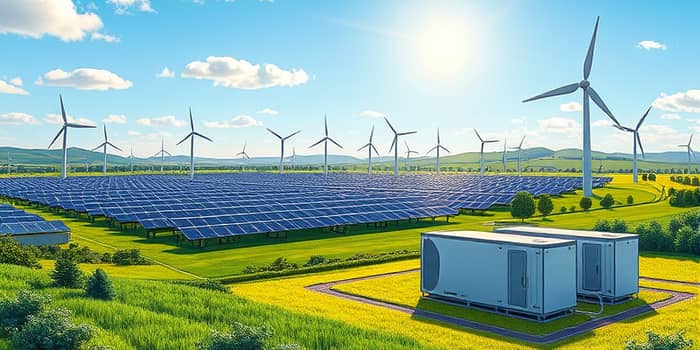Today’s energy transition is more than a technical shift; it’s a massive multitrillion-dollar growth opportunities that holds the key to resilient returns and a healthier planet.
As governments, corporations, and consumers align around environmental goals, the case for deploying capital in clean energy solutions has never been stronger. From solar power to green hydrogen, the momentum is undeniable, and investors who act now can position their portfolios for decades of sustainable growth.
Why Green Technology Investment Matters
In 2025, for the first time, global investments in clean energy are set to outpace upstream oil and gas. This landmark shift signals a fundamental realignment in energy markets. Solar photovoltaic (PV) accounted for half of all clean tech capital expenditures last year, while battery storage investment surged by over 20%, exceeding $50 billion.
Institutional interest continues to rise. ESG-focused assets could reach $33.9 trillion by 2026—over 20% of global assets under management. Meanwhile, U.S. venture capital funneled $7.6 billion into early-stage clean energy deals in 2024, up 15% year on year. Such figures reflect both financial promise and a collective drive toward sustainable progress.
Key Drivers Shaping the Clean Tech Revolution
Several powerful trends are propelling clean technology into the mainstream. Understanding these drivers can help investors spot opportunities and anticipate challenges.
- Cost competitiveness accelerates adoption: Lithium-ion battery prices dropped over 90% in the last decade and fell another 40% in 2024, revolutionizing economics for storage deployments.
- Policy incentives fuel rapid expansion: Acts like the U.S. Inflation Reduction Act offer tax credits, grants, and support for domestic manufacturing, boosting project viability.
- Technological breakthroughs unlock new frontiers: Advances in AI, robotics, and grid analytics streamline operations, while green hydrogen and circular economy solutions gain commercial traction.
Sector Highlights: Opportunities at Every Corner
Clean technology spans a spectrum of industries, each with unique risk–reward characteristics:
Beyond these pillars, emerging fields such as sustainable aviation fuels (SAF) and industrial decarbonization are transitioning from pilot phases to commercial scale, creating fresh opportunities for early investors.
Navigating Risks and Mitigating Challenges
Every high-growth sector carries unique uncertainties. Clean technology investors must proactively manage these risks:
- Technological risk can affect scale-up timelines, particularly in unproven green hydrogen or advanced nuclear projects.
- Shifting regulatory regimes can alter incentives and impact project economics.
- Supply-chain oversupply or price volatility can compress margins, especially in mature manufacturing segments.
By staying informed on policy changes, diversifying across sub-sectors, and partnering with experienced operators, investors can balance risk and reward effectively.
Strategies to Future-Proof Your Portfolio
Implementing a robust investment approach involves combining various tools and tactics:
- Allocate capital across early-stage innovation to capture high-growth potential while maintaining exposure to established players.
- Utilize ESG-themed funds or green bonds for diversified access to clean tech infrastructure.
- Track emerging policy frameworks to identify new subsidy and incentive opportunities early.
- Collaborate with specialist advisors who deeply understand renewable energy markets.
Timing matters. Première investments can secure valuation advantages, while patient capital benefits from continued cost declines and expanding market demand.
Hot Themes to Watch in 2025
Key segments poised for significant expansion include:
- Grid-scale solar paired with intelligent inverters and IoT management.
- Long-duration energy storage technologies beyond lithium-ion.
- Green hydrogen production and export infrastructure rollouts.
- Sustainable aviation fuels paving the way for decarbonized air travel.
- AI-powered grid optimization and digital energy trading platforms.
- Circular economy models in industrial recycling and materials reuse.
Conclusion: Seizing the Green Frontier
The global shift toward a low-carbon economy is reshaping capital markets and unlocking new pathways to value creation. By aligning investments with this structural transformation, investors can pursue attractive returns while supporting a sustainable future.
Now is the moment to embrace change, diversify strategically, and maintain a long-term perspective. For investors seeking to future-proof their portfolios against energy transition, the time to act is now. With disciplined research, diversified exposure, and a commitment to sustainability, one can harness the full potential of green technology and help steer the world toward a prosperous, resilient tomorrow.
References
- https://about.bnef.com/energy-transition-investment/
- https://www.weforum.org/stories/2025/01/4-key-trends-to-watch-in-clean-energy-technology-in-2025/
- https://emerald.vc/top-climate-tech-trends-2025/
- https://www.svb.com/trends-insights/reports/future-of-climate-tech/
- https://www.certificadosenergeticos.com/wp-content/pages/investing_in_green_technologies__prospects_and_risks.html
- https://www.keyesg.com/article/50-esg-statistics-you-need-to-know-in-2024
- https://www.plugandplaytechcenter.com/insights/green-hydrogen-investment-funding-tech-market-trends-2025










